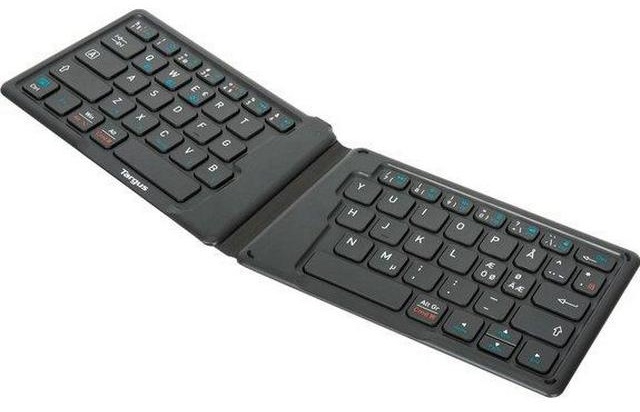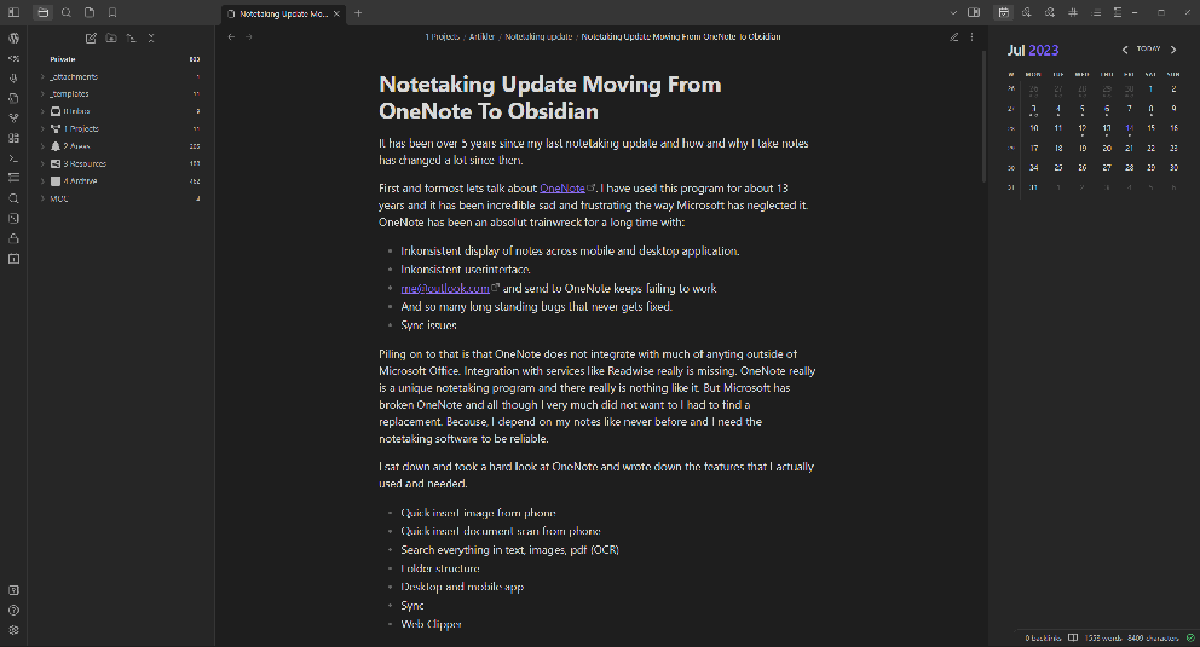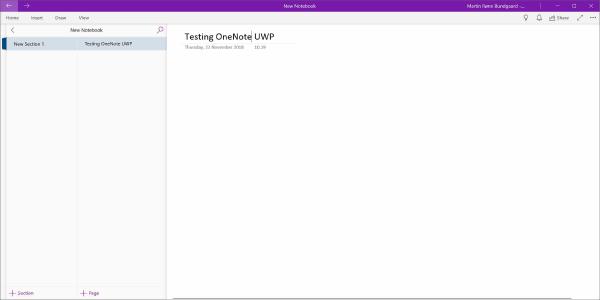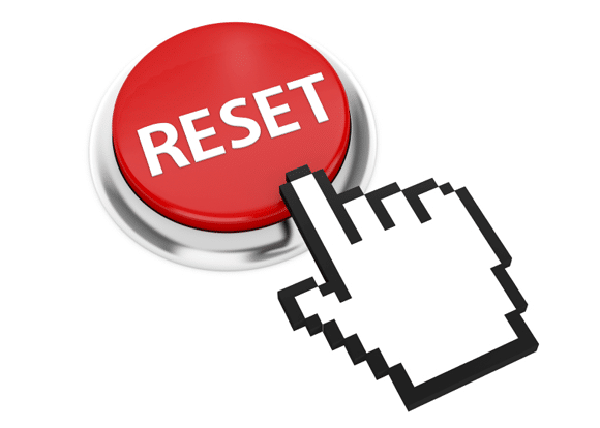It has been over 5 years since my last notetaking update and how and why I take notes has changed a lot since then.
First and foremost let’s talk about OneNote. I have used this program for about 13 years and it has been incredibly sad and frustrating the way Microsoft has neglected it. OneNote has been an absolute trainwreck for a long time with:
- Inconsistent display of notes across mobile and desktop applications.
- Inkonsistent userinterface.
- me@outlook.com and send to OneNote keeps failing to work
- And so many long-standing bugs that never get fixed.
- Sync issues
Piling on to that is that OneNote does not integrate with much of anything outside of Microsoft Office. Integration with services like Readwise really is missing. OneNote really is a unique notetaking program and there really is nothing like it. But Microsoft has broken OneNote and though I very much did not want to I had to find a replacement. Because I depend on my notes like never before and I need my notetaking software to be reliable.
I sat down and took a hard look at OneNote and wrote down the features that I actually used and needed.
- Quick insert image from phone
- Quick insert document scan from phone
- Search everything in text, images, pdf (OCR)
- Folder structure
- Desktop and mobile app
- Sync
- Web Clipper
Obsidian Setup#
I do procrastinate from time to time (okay I procrastinate all the time) and play with other notetaking software. Last year I tried out a bunch of notetaking software.
I really liked Obsidian but I was not ready to give up on OneNote just yet at the time. However, a few months later I was again having issues with OneNote and I decided that now was the time to move. Switching notetaking tools for me is a very big deal. As I already have mentioned I rely heavily on my notes. They are an extension of me. My so-called “second brain”.
I spend a couple of days watching a lot of videos on Obsidian workflows and then spend time setting it up and then just got back to work. One of the things I do a lot in my notes is write daily logs where I document work and write about my day. Obsidian has this concept of a daily note that works quite well with how I use my notes. I implemented a lot of the ideas from this Daily Notes First Workflow YouTube series. That in combination with Tiago Forte’s PARA method for organizing notes. I have already used PARA for over a year because I converted my OneNote to use PARA and that has worked quite well. So I organized Obsidian the same way.
Existing Notes#
What about all my existing notes you might ask. Well, I already years ago ported all my notes from OneNote to a generic markdown format. This is sadly not the first time I have tried to move away from OneNote. You can read about that in my article I Say Goodbye To Microsoft OneNote. It will be the last though. This new breed of markdown-based notetaking apps is actually good. So, it was fairly easy for me to move from OneNote to Obsidian. I only had to convert the newer notes to markdown and dump them into Obsidian along with all my old notes. It still took a lot of time though.
I have used this setup exclusively for about 7 months now and I am quite happy with it. One of the cool things about Obsidian is that it is the same application on desktop and mobile with only very few differences. That is one of the reasons I really like Obsidian as I write most my daily notes on my iPhone. I could not afford a tablet or small laptop to write notes with, out and about. So I got a foldable Bluetooth keyboard instead to use with my iPhone 13 mini. This has turned out to be quite the combo and works so well that now I do not want a tablet.


Web Clipping#
One thing that took some time to figure out was a web clipper that works with Obsidian. When I used OneNote I use the OneNote clipper almost every day and I needed one that work with Obsidian. What I need the clipper to do is.
- Screenshot whole page
- Screenshot part of a page
- Extract article text.
One and two were quite easy. As it turns out the browser I use, Edge has this feature built-in and is only a right click away. Three took me a while to find a workable solution. But, I found one called MarkDownload that works well enough. It has Obsidian integration via the context menu. I could not get it to download images into Obsidian. I want whatever I put into my notes to be in my notes and not show content from the internet as that tent to disappear over time. So I use the plugin Local Images Plus that automatically downloads externally linked images and replaces the link in the notes with the local one. Quite nifty.
Another thing missing in Obsidian that I used all the time in OneNote is document scanning. The solution here is to just use a scanning app and share it with Obsidian. But most scanning apps are expensive and require a monthly subscription to enable the sharing function. However, I already had Microsoft Lens installed as I have used it for many years, and sharing it with Obsidian works quite well. But, it is not as quick to scan and insert a document as the integrated one in OneNote.
Search#
This is the one where every markdown-based notetaking app I have tried in the past has failed. I add a lot o images and document scans to my notes and I need them to be searchable. Obsidian built-in search cannot handle this. But, the plugin Omnisearch can and it works really well. It only indexes on the desktop. However, once indexed search can be done on both desktop and mobile and it is all done locally. The fact Obsidian has OCR search via a plugin is perhaps the biggest reason I am able to use it.
Plugins#
Speaking of plugins as of this writing I use 15 community plugins. I am trying to use as few as possible. Some plugins are nice to have and some are absolutely essential.
- Advanced Tables (Nice to have)
- Advanced URI (Nice to have)
- Calendar (Essential)
- Clear Unused Images (Nice to have)
- Dataview (Essential)
- File Explorer Note Count (Nice to have)
- Icon Folder (Nice to have)
- Local Images Plus (Nice to have)
- Meld Encrypt (Essential)
- Omnisearch (Essential)
- Periodic Notes (Essential)
- Readwise Official (Nice to have)
- Templater (Essential)
- Text Extractor (Essential)
- WordPress (Nice to have)
I am trying to keep the number of plugins and especially community plugins to a minimum. I will let you judge if I failed or succeeded at that.
Sync#
At the moment I have an iPhone 13 mini. I am not a die-hard iPhone or Android user I have used them both and like them both. I chose an iPhone this time because I wanted a small phone and there was not many phone to choose from. I will say that together with the Apple Watch I like it very much. Anyway, I use an iPhone which limits my sync options quite a bit. Had I been using Android I would have used Syncthing as I already use that all over the place. But, I use an iPhone. So, my option is iCloud or Obsidian Sync. I tried iCloud which works terribly together with Obsidian on Windows I had sync conflicts contently.
So I chose to use Obsidian Sync. For what it is it is quite expensive. I am getting a full Office 365 with 1 TB of OneDrive storage for about the same price as Obsidian Sync with 10 GB of storage. That is a bit steep, but I guess I then also help fund the future development of Obsidian. The nice thing about Obsidian Sync is that it is easy to set up, it work very well, and is end-to-end encrypted.
Conclusion#
As I wrote earlier I have used Obsidian for about 7 months now. I did not set it up all at once but slowly over time and I am sure it will continue to evolve. But I am quite happy with what I got and It is a lot more capable than OneNote ever was.





